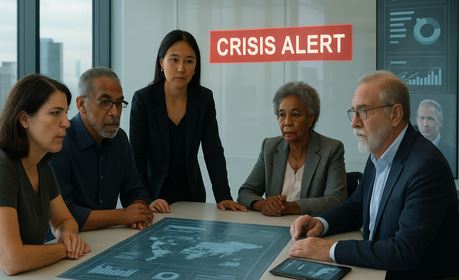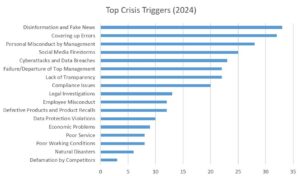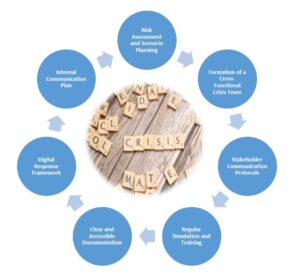Monday, December 01, 2025
Monday, December 01, 2025

by Natja Igney:
This is the first in a series of three articles, each exploring a critical phase of crisis communications and reputation management. Although tactical responses are typically delegated to middle management, strategic responsibility – including the function of facing the public – lies unequivocally with the C-suite.
The three instalments will address:
* The business case for crisis preparedness
* The Dos and Don’ts of crisis communications at C-level
* Mitigating reputational damage
PART 1: Crisis Preparedness – The Strategic Safety Net No Organization Can Afford to Ignore
Executive Summary
As Warren Buffett famously observed, “It takes 20 years to build a reputation and five minutes to ruin it.” Companies that invest in comprehensive crisis preparation acknowledge this reality and protect their most valuable asset: trust.
While many business leaders tend to focus on the handling of a crisis once it has hit, preparedness often seems to come as an afterthought, or even just a “nice-to-have”.
Preparation is not optional though – it is essential. This includes understanding where a crisis might come from, implementing safeguards to help prevent it from occurring in the first place, and establishing protocols for effective response when prevention fails.
The investment in comprehensive preparation pays dividends not only when crises strike but in building organizational resilience, stakeholder confidence, and operational excellence.
This article outlines the rationale for proactive crisis planning and provides a framework for embedding readiness into strategic operations with the goal of recovering faster, maintaining stakeholder trust, and limiting long-term damage.

Data source: PR Trend Monitor 2024
The data highlights the increasing significance of digital threats such as disinformation and cyberattacks, as well as internal challenges like management misconduct, fair or unfair social media exposure, and lack of transparency.
Defining a Crisis
A crisis is a significant, unexpected event that threatens an organization’s operations, finances, reputation, or stakeholders, and requires immediate, strategic response beyond routine problem-solving procedures. Unlike everyday business challenges, a crisis typically involves public scrutiny, potential long-term damage, and the need for senior leadership involvement.
The Business Case for Crisis Preparedness
No organization wants to face a crisis, yet virtually every company will encounter one at some point in its existence. From data breaches and product recalls to executive misconduct and social media firestorms – crises often strike without warning. Treating crisis planning as a discretionary investment is a strategic misstep that exposes the organization to preventable harm.
Crisis preparedness is not merely a contingency plan; it is a fundamental business necessity – as essential as financial audits, cybersecurity protocols, or insurance policies. This article explores why proactive crisis preparation is critical, what effective preparation entails, and how it can prevent minor issues from escalating into full-blown crises.
The Cost of Unpreparedness
Too often, leadership teams underestimate the consequences of inadequate crisis planning. The following data points (2023-24) illustrate that the financial and reputational impact of a mishandled crisis extends far beyond immediate operational disruptions:
| Metric | Unprepared Organizations | Prepared Organizations | Source |
| Business leaders having experienced a crisis in their organization | 59% | 59% | PwC Global Crisis Survey |
| Businesses having a documented crisis plan | >5% | 32% | PwC Global Crisis Survey |
| Share value impact in week 1 during crisis | Up to 50% irrecoverable losses | Average of 22% decline, usually recoverable | Oxford Metrica |
| Average cost of a data breach (2023) per incident | €3.9m | €1.5m (-38%) with response teams and tested plans | IBM Cost of a Data Breach Report |
| Businesses not recovered after 5 years | 40% | 4% | Gartner Annual Report |
| Reputation recovery time compared to financial recovery | 3.5 times longer | Equal or near values | Weber Shandwick |
| Cost of legal liabilities compared to initial financial damage | 2.5 times higher | Typically below initial financial damage | Deloitte Crisis Management Survey |
| Communications spend during crisis | Depends on the situation but typically millions of € | 33% savings with proactive preparation | CMI Crisis Management Report |
“It Won’t Happen to Us”: The Dangerous Assumption
Many organizations operate under the assumption that crises happen to other companies, not them. This psychological bias, known as optimism bias, creates dangerous organizational blind spots.
Research by the Business Continuity Institute shows that 82% of organizations that suffered major crises admitted they had seen early warning signs but failed to act on them. Such blind spots reinforce the need for crisis preparation to be embedded into organizational culture, and not treated as an afterthought.
Key Components of an Effective Crisis Plan
Crisis preparedness is not a binder on a shelf. It is neither a one-off initiative nor a static task, but a non-negotiable component of good governance, and evolves along with changing markets, policies, and technologies. Rather, it is an integrated system.
The following steps are a great starting point to turn plans into action, to be done in-house or with the help of a specialized consultant:
* Conduct a vulnerability audit to identify your organization’s specific risk profile
* Develop a crisis management policy that outlines governance and authority during crises
* Assemble and train a core crisis team with clear roles and responsibilities
* Create communication templates for different scenarios and stakeholder groups
* Establish monitoring systems to identify emerging issues before they escalate
* Test your plans through realistic simulation exercises
* Review and revise your approach based on simulation learnings and post-crisis analysis

Case Study: The Tale of Two Responses
The Unprepared: Boeing’s 737 MAX 9 Crisis (January 2024)
When a door plug blew out of an Alaska Airlines Boeing 737 MAX 9 in January 2024, Boeing’s response revealed significant crisis preparation gaps. CEO Dave Calhoun initially remained silent for several days, creating a leadership vacuum. When the company finally addressed the issue, their communications were inconsistent and defensive.
The FAA grounded all 171 MAX 9 jets, and Boeing’s slow response to safety concerns exacerbated stakeholder frustration. Their crisis readiness appeared minimal, with no clear spokesperson strategy or consistent messaging framework. Boeing’s stock dropped nearly 20% in the weeks following the incident, erasing about $25 billion in market value.
The crisis also revived memories of earlier 737 MAX problems from 2018-2019 (when two fatal crashes led to a worldwide grounding of those aircraft), compounding reputational damage with both regulators and the flying public. This demonstrates how past crisis mishandling creates vulnerability for future incidents.
The Prepared: Ticketmaster/Live Nation Taylor Swift Tour Crisis (November 2022)
When overwhelming demand for Taylor Swift’s Eras Tour crashed Ticketmaster’s systems and left millions of fans unable to purchase tickets, the company initially appeared unprepared. However, internally Live Nation Entertainment (Ticketmaster’s parent company) was already deploying established crisis mechanisms for effective recovery. Within 24 hours, LNE
* issued a detailed technical explanation of the system failure
* apologized directly to consumers and to Swift herself
* engaged proactively with regulatory bodies, and
* Implemented a transparent remediation plan for affected customers.
Clearly established crisis protocols allowed them to address multiple stakeholders simultaneously. While they still faced congressional scrutiny, their rapid, coordinated response prevented a much worse financial and reputational outcome. Their stock recovered within weeks, demonstrating how prepared crisis infrastructure can limit damage even when the initial problem was severe.
Takeaway
The Boeing case demonstrates how even established companies can fail at crisis basics – prompt leadership visibility, consistent messaging, and transparent communication. Their delayed and defensive response serves as an effective cautionary tale.
Meanwhile, the Ticketmaster example shows how having crisis protocols in place allowed for rapid recovery from what could have been a much more damaging situation. Their multi-stakeholder approach demonstrates the value of preparation even when the initial crisis response is not, or does not appear to be, perfect.

Cultural and Regional Considerations
Crisis response expectations vary significantly across different cultures and regions. International organizations must consider:
* Local regulatory requirements for disclosure and reporting
* Cultural expectations regarding leadership visibility
* Regional media landscapes and stakeholder expectations
* Language considerations and translation protocols
Conclusion
Crises happen. You just never know when they will strike.
But crisis preparedness marks the distinction between organizations that merely survive disruptions and those that emerge stronger from them. The evidence is clear: companies with robust crisis readiness not only weather storms more effectively but also transform potential disasters into demonstrations of leadership, resilience, and transparency.
When stakeholder trust can evaporate within hours, crisis preparation transcends risk management to become strategic positioning. Organizations that integrate crisis readiness into their governance structures protect their most valuable marketplace asset: reputation.
The question for leadership teams is no longer whether they can afford to invest in comprehensive crisis preparation, but whether they can afford not to make this essential investment in organizational resilience and reputation protection.

What’s next?
The next article in this series will explore how senior leadership responds when crisis strikes – the moment when preparation converts to action. This is the decisive test that determines whether stakeholder trust will be preserved or permanently damaged.
About the Author
Natja Igney is an independent media and communications strategist with a global career spanning over 25 years in corporate communications, crisis communications, and reputation management. Her experience as an executive coach and media trainer helps companies prepare for and navigate complex stakeholder-facing situations. Dually based in France and Canada, she is fluent in English, French, and German. Visit her website and connect with her on LinkedIn.
Written by: Editor
© 2025 Stratpair Ltd., trading as Strategic. Registered in Ireland: 747736